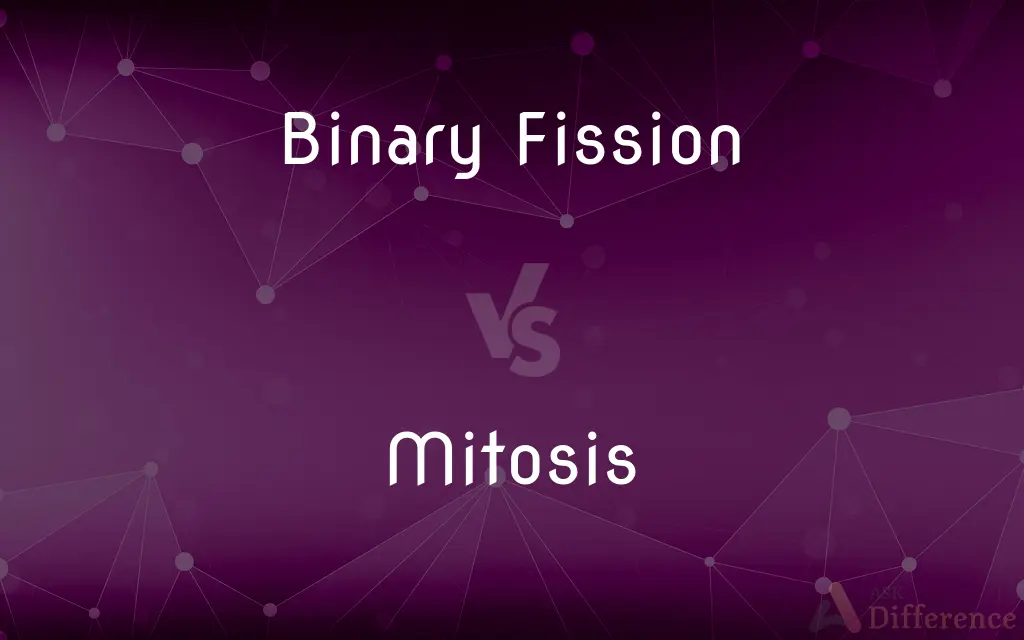Binary Fission vs. Mitosis — What's the Difference?
Edited by Tayyaba Rehman — By Fiza Rafique — Published on December 23, 2023
Binary Fission is a simple cell division in prokaryotes; Mitosis is eukaryotic cell division ensuring genetic consistency. Both are reproductive mechanisms.

Difference Between Binary Fission and Mitosis
Table of Contents
ADVERTISEMENT
Key Differences
Binary Fission is primarily observed in prokaryotic organisms, such as bacteria. This process results in the division of a single cell into two genetically identical daughter cells. In contrast, Mitosis is the process by which a eukaryotic cell divides its nuclear content, producing two identical nuclei within a single cell.
Binary Fission begins when the DNA of the cell replicates and the cell elongates. As the process continues, the cell pinches in the middle until two daughter cells form. Mitosis, on the other hand, involves a series of intricate steps, including prophase, metaphase, anaphase, and telophase, ensuring a precise and orderly distribution of chromosomes.
Binary Fission does not involve the formation of any structures like the spindle fibers or centrioles, which are essential for Mitosis. In Mitosis, spindle fibers help in the separation of chromatids, ensuring each daughter cell gets an accurate copy of the genetic material.
In Binary Fission, the resulting daughter cells are often of similar size. The process is direct and straightforward. Meanwhile, Mitosis, especially in multicellular organisms, is followed by cytokinesis, the division of the cell's cytoplasm, resulting in two distinct daughter cells.
Binary Fission is the primary mode of reproduction for many unicellular organisms, ensuring their rapid proliferation. Mitosis, in contrast, supports growth, development, and repair in multicellular eukaryotic organisms. Both processes underline the significance of cell division in life.
ADVERTISEMENT
Comparison Chart
Organisms
Prokaryotes (e.g., bacteria)
Eukaryotes (e.g., animals, plants)
Process Complexity
Simple division
Multi-step process
Structures Involved
No special structures
Spindle fibers, centrioles
Result
Two similar-sized daughter cells
Two distinct daughter cells
Purpose
Reproduction in unicellular organisms
Growth, repair, and development in multicellular
Compare with Definitions
Binary Fission
Binary Fission involves simple cell division without complex processes.
Unlike eukaryotes, Binary Fission in bacteria doesn't involve spindle fibers.
Mitosis
Mitosis is the division of a cell's nucleus in eukaryotes.
Human cells undergo Mitosis for growth and repair.
Binary Fission
Binary Fission is direct and doesn't involve intermediate stages.
Binary Fission in amoebas divides them directly into two parts.
Mitosis
Mitosis has several stages, including prophase and anaphase.
During Mitosis, chromosomes align at the center during the metaphase stage.
Binary Fission
Binary Fission is rapid and efficient.
The quick spread of bacterial infections is due to their ability to reproduce via Binary Fission.
Mitosis
Mitosis ensures precise chromosome distribution.
Mitosis maintains genetic consistency across cells.
Binary Fission
Binary Fission is a type of asexual reproduction in prokaryotes.
Bacteria often reproduce through Binary Fission.
Mitosis
Mitosis results in two genetically identical nuclei.
After Mitosis, two cells have the same genetic information as the original cell.
Binary Fission
Binary Fission results in two genetically identical cells.
A single bacterium, through Binary Fission, can become two bacteria in a short time.
Mitosis
Mitosis is fundamental for multicellular organism development.
As an embryo develops, its cells multiply through Mitosis.
Mitosis
The process in cell division by which the nucleus divides, typically consisting of four stages, prophase, metaphase, anaphase, and telophase, and normally resulting in two new nuclei, each of which contains a complete copy of the parental chromosomes.Also called karyokinesis.
Mitosis
The entire process of cell division including division of the nucleus and the cytoplasm.
Mitosis
(cytology) The division of a cell nucleus in which the genome is copied and separated into two identical halves. It is normally followed by cell division.
Mitosis
See Karyokinesis.
Mitosis
Cell division in which the nucleus divides into nuclei containing the same number of chromosomes
Common Curiosities
Why is Mitosis important for multicellular organisms?
Mitosis supports growth, repair, and development in multicellular organisms by producing genetically identical cells.
How does Mitosis differ from Binary Fission?
Mitosis is a multi-step process in eukaryotes ensuring accurate chromosome distribution, while Binary Fission is a simpler division in prokaryotes.
Is Binary Fission exclusive to bacteria?
Mostly, but some unicellular eukaryotes also use Binary Fission for reproduction.
What ensures cell growth in prokaryotes?
Binary Fission ensures rapid and efficient reproduction and growth in prokaryotes.
Which is more complex: Binary Fission or Mitosis?
Mitosis is more complex, involving several stages and structures, compared to the direct Binary Fission.
What is Binary Fission?
Binary Fission is a simple cell division mechanism in prokaryotes, resulting in two identical cells.
Does Binary Fission involve the formation of spindle fibers?
No, Binary Fission does not involve structures like spindle fibers, unlike Mitosis.
What follows after Mitosis in multicellular organisms?
In multicellular organisms, Mitosis is typically followed by cytokinesis, dividing the cell's cytoplasm.
Is Mitosis the only cell division method in eukaryotes?
No, there's also meiosis, which is responsible for producing gametes in sexual reproduction.
How do chromosomes behave in Mitosis?
In Mitosis, chromosomes align, separate, and are distributed evenly to the daughter cells.
Is Binary Fission a form of asexual reproduction?
Yes, Binary Fission is a type of asexual reproduction producing genetically identical offspring.
Are the cells produced by Binary Fission identical?
Yes, Binary Fission produces two genetically identical daughter cells.
Can eukaryotic cells reproduce by Binary Fission?
Rarely, some unicellular eukaryotes can reproduce by Binary Fission, but most eukaryotes use Mitosis.
How do Mitosis and Binary Fission relate to organism complexity?
Mitosis is crucial for the development and maintenance of complex multicellular organisms, while Binary Fission supports simpler unicellular organisms.
What ensures the accuracy of chromosome separation in Mitosis?
Structures like spindle fibers and centrioles ensure accurate chromosome separation during Mitosis.
Share Your Discovery

Previous Comparison
Consumer Market vs. Organizational Market
Next Comparison
Microsoft A3 vs. Microsoft A5Author Spotlight
Written by
Fiza RafiqueFiza Rafique is a skilled content writer at AskDifference.com, where she meticulously refines and enhances written pieces. Drawing from her vast editorial expertise, Fiza ensures clarity, accuracy, and precision in every article. Passionate about language, she continually seeks to elevate the quality of content for readers worldwide.
Edited by
Tayyaba RehmanTayyaba Rehman is a distinguished writer, currently serving as a primary contributor to askdifference.com. As a researcher in semantics and etymology, Tayyaba's passion for the complexity of languages and their distinctions has found a perfect home on the platform. Tayyaba delves into the intricacies of language, distinguishing between commonly confused words and phrases, thereby providing clarity for readers worldwide.











































